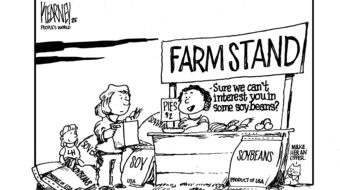
The total number of jobs went up by 200,000 in December, and the official jobless rate dropped to 8.5 percent from 8.6 percent in November, according to the U.S. Department of Labor report released this morning.
The official unemployment rate went down 0.6 percentage pints since August, and the number of workers officially unemployed fell to 13.1 million from close to 14 million.
Most of the new jobs last month went to adult men, for whom the official unemployment rate decreased to 8 percent.
The official jobless rates for adult women (7.9 percent), teenagers (23.1 percent), blacks (15.1 percent) and Latinos (11 percent) showed almost no change. The unemployment rate for Asians was 6.8 percent.
Most industries added jobs, but construction and government were the notable exceptions. The new report shows that in 2011, 280,000 jobs were cut in local government, state government and the U.S. Postal Service.
During the month of December, transportation and warehousing jobs rose by 50,000 and manufacturing jobs by 23,000. Retail jobs grew in December by 29,000. Health care added 23,000 jobs and mining jobs rose by 7,000. Over the entire year, mining jobs increased by 89,000.
While labor economists consider the news positive, they are warning that the pace of job creation is still far below what is necessary to bring the jobless rate back to pre-recession levels.
“The jobs deficit left from losses in 2008 and 2009 remains well over 10 million jobs,” said Heidi Shierholz, an economist at the Economic Policy Institute. “Even at December’s growth rate, it would take about seven more years – until around 2019 – to fill that gap and get back to the pre-recession unemployment rate. We need reports this strong and stronger for many years to come to bring our labor market back to health.”
EPI notes that the total number of jobs added for 2011 was 1.6 million but that the figure would have been 1 million less than that had the bullet congressional conservatives aimed at the heart of the economy earlier in the year reached its target. “A budget plan passed by the Republican controlled House early in 2011 would have slashed close to a million jobs off the total had it gone into full effect,” said Shierholz.
Several economists at EPI warn that American workers face much more than just the problem of high unemployment rates. They say that even U.S. workers with jobs now face unprecedented problems related to income inequality and lack of mobility.
Elise Gould and Natalie Sabadish, also at EPI said, in their report today, that “in a world of perfect mobility, people will be able to move up in the income distribution with hard work and dedication, regardless of where in the distribution they started out..” Their report finds, however, that “high income students who have low test scores are more likely to graduate from college than low-income students with high test scores.”
Their report finds African Americans to be severely impacted by this situation:
“African Americans who start out in the bottom 25 percent of the income distribution are nearly twice as likely to remain there than whites. In addition, white Americans who start out in the bottom 25 percent are about four times more likely to make it to the top 25 percent of the income distribution than Blacks.”
Almost all the economists at EPI say that, contrary to positions taken by right wing lawmakers, raising wages, not just hiking the number of jobs, is critically important to the process of fixing the economy. They see raising the minimum wage, for example, as critical to tackling the problem of inequality.
In this week’s Economic Snapshot, EPI shows that of the 1.4 million low-wage workers who will benefit from Jan. 1 minimum wage increases, 80 percent are at least 20 years old and 78 percent work at least 20 hours per week. Conservative lawmakers argue that minimum wage rates need to be kept low so that there will be jobs for teenagers. “The percentage of affected minimum wage workers who fit that false stereotype of teenage, part time workers is a mere 12 percent,” says EPI.
Also key to economic recovery, say EPI economists, is stopping the Republican attacks on unions.
Economists at EPI are riled over the latest attempts to turn Indiana into a “right to work” state. They are working overtime to show the falsehood of right wing claims that right-to-work laws stimulate economic growth.
EPI research associate Gordon Lafer has been disputing conservative claims that a “right to work” law in Indiana is needed to create jobs and raise wages.
He found that right to work laws reduce wages by $1,500 at least, for both union and non-union workers and that they have no impact on job growth in states that adopt them.
Photo: Laborers International Union of North America










